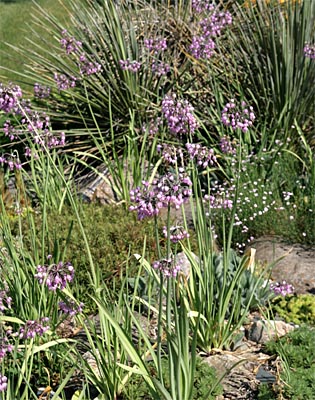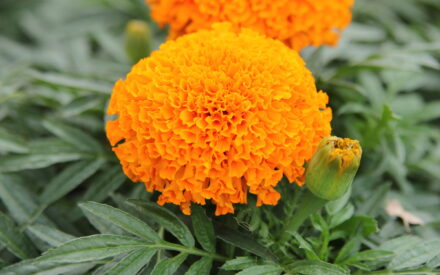
There are many ornamental flowering onions that offer a variety of unusual shapes and forms. The nodding onion, Allium cernuum (cernuum means nodding in Latin) is an attractive small species native to North America, distributed from New York to Michigan and British Columbia and south in the mountains and cooler regions from Arizona and North Georgia (= A. recurvatum). It occurs on rocky soils in glades, bluff edges, open woods, dry meadows and prairies throughout its native range. Because of its wide distribution, it is variable in plant size, flower color and bloom time. As with other members of the genus, it has the characteristic, pungent onion aroma. It is hardy in zones 4-8.
The plants grow 8-18” tall, forming attractive clumps. Flat, narrow, grass-like leaves emerge from a slender conic bulb with a brown membranous outer layer. The foliage persists into late summer before dying back. The clumps slowly expand by making new offsets.
Each mature bulb typically bears a single flowering stem with up to 30 flowers. The light pink to lavender or occasionally white flowers are produced in loose, pendulous umbels like little fireworks atop erect, leafless scapes (flower stems) rising slightly above the foliage. The scapes bend sharply downward at the top so that the umbel droops downward. The small bell-shaped flowers have protruding stamens. The plants bloom in early to mid-summer and are attractive to butterflies and bees.

After the flowers fade, a very decorative seed head remains. Spherical crested fruits later split open to release the dull black seeds, each with a honey-comb pattern on the surface.

A. cernuum is a great addition to the rock garden, borders and cottage gardens. They naturalize well, so look at home in natural landscapes, wild gardens and meadows but can also be an attractive addition to formal gardens. It is most effectively planted in small groups and is best interplanted with other perennials to hide the declining foliage. It will grow up nicely through wild geranium (Geranium maculatum and other species) or other low groundcovers. Try planting it in front of Liatris ‘Kobold’ (a compact variety) or near winecups (Callirhoe involucrata) that will ramble around the bulbs.
Nodding onion is very easy to grow. It prefers well-drained soil in full sun but will tolerate clay soils. It thrives in difficult sites such as hot sun and gravely soil. Divide every third year or when 8-10 bulbs appear in the clump.

This allium will self seed, so deadhead flowers before seed sets to reduce unwanted spread. Plants are easily grown from seed or can be ordered as bulbs. Seeds can be sown in a cold frame or indoors well before last frost. Collect seeds when the seed capsules turn tan or straw-colored but before they open and when the seeds are black. Seeds can be stored under refrigeration for up to 3 years. Plants will start blooming in their second or third year after sowing. Plants can also be propagated by division in early spring or fall.
Like other alliums, A. cernuum is has few pests. It is edible and although the strongly flavored leaves and bulbs were once used for food, it is not considered to have any culinary value today. Native Americans used the bulbs for medicinal purposes. Some wildlife, such as bears and ground squirrels will eat the bulbs. Elk and deer may graze the new spring growth but nodding onion is generally considered deer resistant.
The species is available as seed or plugs from various native plant nurseries. The cultivar ‘Major’ produces larger plants and larger flower clusters than the species. ‘Leo’ has white flowers sometimes tinged with pink, shorter leaves and is later flowering than many types. ‘Oxy White’ is another white-flowered form that was once classified as a different species, O. oxyphilum, and is supposed to be slower growing. ‘Hidcote’ is an English selection that is taller than the typical form, with larger flower heads and rose purple flowers. It was given a Royal Horticulture Society Award of Garden Merit.
– Susan Mahr, University of Wisconsin – Madison
Ask Your Gardening Question
If you’re unable to find the information you need, please submit your gardening question here:





 Asters, Symphyotrichum spp.
Asters, Symphyotrichum spp. Fascinating Fasciation
Fascinating Fasciation Alternatives to Lawn: Groundcovers
Alternatives to Lawn: Groundcovers Marigolds
Marigolds


